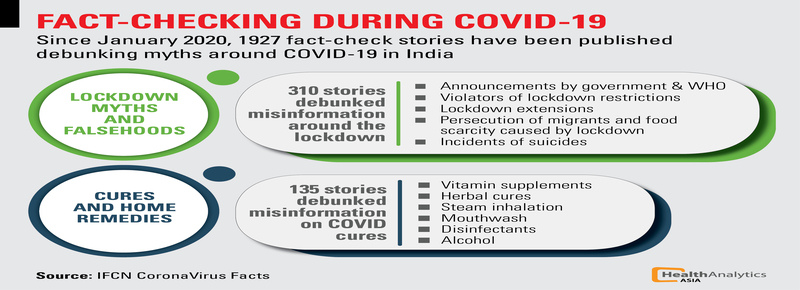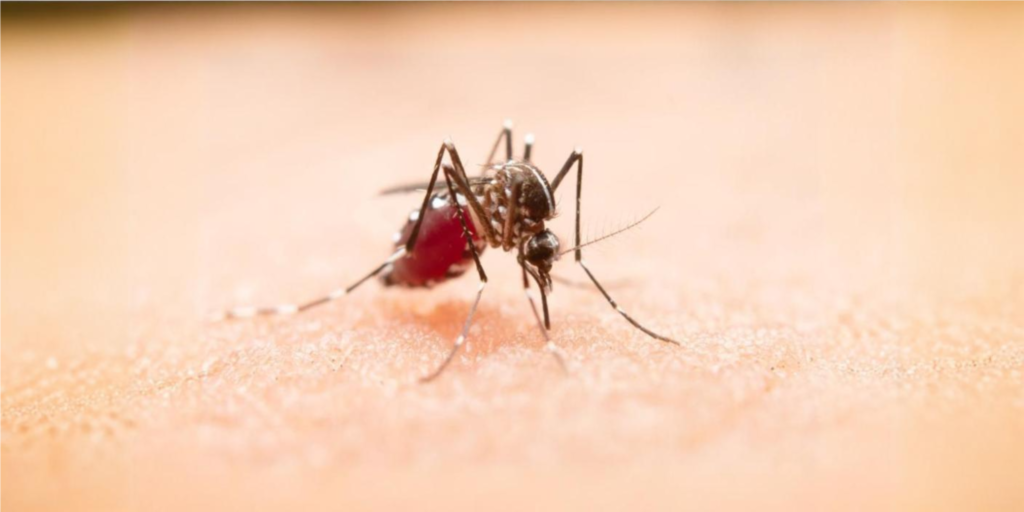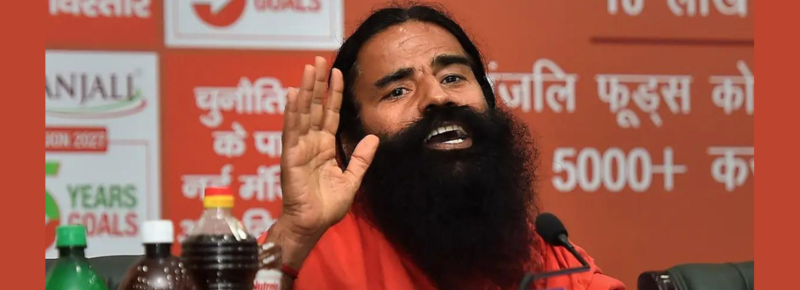Tags
How Indian fact-checkers dealt with COVID-19 misinformation
Author
Author
- admin / 3 years

- 0
- 6 min read

An analysis of International Fact Checking Network’s repository of fact-checked stories to understand the trends of misinformation in 2020.
By Nabeela Khan
In mid-February 2020, the World Health Organisation announced that the new coronavirus pandemic was accompanied by an ‘infodemic’ of misinformation. Little did we know that the avalanche of misinformation will be so gigantic that fact-checking organisations in India alone will end up checking 1927 claims in between January, 2020 and December 2020.
To analyse the misinformation landscape over the past one year, we collated data from International Fact-Checking Organisation’s ‘The CoronaVirusFacts’ database – a repository of fact-checked stories by the organisations who are IFCN signatories.
To begin with, we collated a sample of 1927 fact-checked stories from India and found that maximum fact-checks were around lockdowns and cures. We found a total of 310 pieces of misinformation related to lockdowns and 135 pieces of misinformation on cures rated false or misleading by fact-checkers in between January 2020 and December 2020.

India reported its first case of COVID-19 in the last week of January 2020. According to our data sample, first fact-check on Covid-19 was published on January 25th, 2020.
We found that COVID-19 misinformation around lockdowns increased between the month of March 2020 and July 2020, while misinformation on cures started floating from February and continues to remain so.
Lockdowns
False information around the lockdown emerged to be the biggest contributor to misinformation between the month of March 2020 and July 2020.
Misinformation around lockdowns started appearing in March when a self-imposed curfew (Janta curfew) was announced. Citizens were requested to stay at home and express gratitude for frontline workers at 5 PM on March 22, 2020. This was followed by the 21-day lockdown, which was extended for a further 18 days. The country remained in either complete or partial lockdown until March 31st, 2020.
A piece of misinformation widely popular during this time was a fake message about WHO protocol for a COVID-19 curfew followed by proposal to extend lockdowns. During these times, grim pieces of misinformation falsely claiming people committing suicide and people suffering due to food scarcity was widely shared. Images of poor families or children and their mothers with false claims of suicide and deaths went viral on social media.
Videos and audio messages gained wide popularity. False videos showed gathering of huge crowds and women shopping or people breaking lockdown were popular. Misleading information about government schemes and people hoarding food were also shared.
The most bizarre piece of misinformation under this classification was ‘lions and leopards left open to contain COVID-19 spread’.
Migrant workers were also pulled into the narrative around fake news since daily wage earners and migrant workers were left without fewer means of income.
Old videos and photographs were often passed off as fresh incidents during the lockdown.
Of Cures and Remedies
With the continuous rise in COVID-19 cases, misinformation on cure of the virus - most of them home remedies not backed by science - were popular. One of the first pieces of such misinformation was the claim that garlic water was a cure for coronavirus. It was debunked in February 2020, with the World Health Organisation also clarifying then that the novel coronavirus had no specific cure. And yet, garlic as a possible cure revolved, rotated and re-emerged despite being fact-checked. The garlic water theory was later swapped with garlic soup, made with handful of garlic to boiled garlic and so on.
Bizarre cure claims continued to flow, including ‘blowing hot air through a hair dryer’ to ‘drinking bitter gourd juice’ and ‘pigeon faeces slurry’. The most popular claim was around tea, from normal tea to lemon tea to tea mixed with spices. There were claims which explained the chemical substances found in tea. This was followed by ‘effectiveness of turmeric, vitamin supplements and steam inhalation’.
Some other misinformation pieces were eating alkaline foods, applying mustard oil in nostrils, ways to kill the virus through UV rays cocaine and weed as a possible cure. Other home remedies including a mix of lemon aspirin and honey emerged as a promising cure and was widely circulated.
The most dangerous pieces of misinformation which can impact human lives were advices to gargle with bleach or drink alcohol to ward off the virus. People fell victim to such false information and followed advices such as ingesting large quantities of vitamins, self-prescribed natural herbs and immunity boosters. There were also reports from other parts of the world where many died drinking methanol or alcohol-based cleaning products.
After these incidents, the World Health Organization (WHO) responded saying that the "infodemic" surrounding COVID-19 spread just as quickly as the virus itself, with conspiracy theories, rumours and cultural stigma all contributing to deaths and injuries.
What 2021 will witness
The year 2021 is seeing re-emergence of many previous claims being passed off as “according to latest research and latest developments”.
However, the most bizarre piece of misinformation in 2021 has been “hospitals on lockdown as first COVID-19 vaccine patients start eating other patients”.
A preliminary glance at 2021 data highlights the misinformation surrounding COVID-19 vaccinations. Social media posts questioning vaccine side-effects and their efficacy, have contributed to spreading fear of vaccines. With 27 fact checks having been collated in 2021 thus far, an analysis of vaccines and other categories will be covered in second part of this series.
Analysis
In April 2020, misinformation was at its peak, with a maximum of 648 fact checks, followed by the month of March.


To understand this further, we looked at Google trends to know what people were exactly searching for.
Google search trends highlights that the search for COVID-19 cures peaked during the month of March whereas search for lockdowns remained high in April.

This highlights that while the general public might be sceptical of information they come across online, dangerous narratives still lead to damages, physical harms and even cost lives.
An analysis highlights the many different narratives of misinformation, fabricated and fake content about COVID-19, and that it comes in varied forms and from different sources. While fact-checkers provide authoritative analysis of misinformation, our data highlighted overlap in the claims checked and the need to limit similarities.
(With data and graphics by Anuja Venkatechalam)
For fact-checked health misinformation, visit uwsi.firstcheck.in










